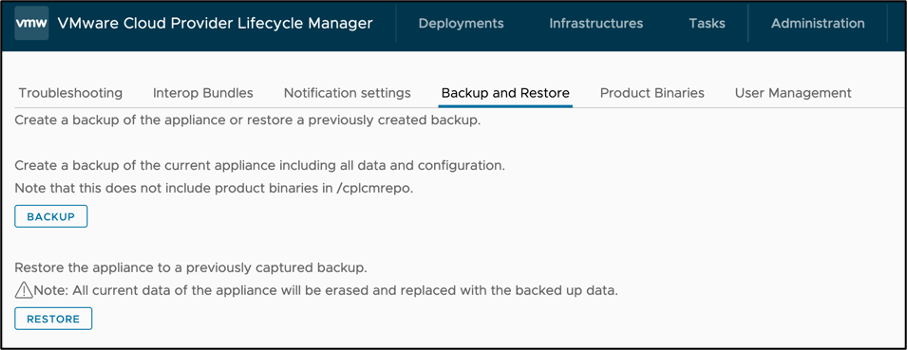
We are happy to announce the general availability of VMware Cloud Provider Lifecycle Manager (VCPLCM) version 1.6 as of 19th October, 2023.
With VCPLCM, we aim to reduce the complexities and simplify the operational efforts of management and maintenance of VMware products for our Cloud Provider Partners. Our focus has been to offload as much efforts of our partners on redundant tasks like upgrading, product management and day-2 operations. Our approach is to automate these process to rule out human errors and minimize maintenance downtimes.
We have been expanding the support for additional products throughout our version releases and have constantly added features that benefit our partners.
In our previous version (VCPLCM 1.5), we brought the auto registration of Usage Meter and Interop Reporting along with enhancements around task execution. In this release we bring you some great additions with the main focus on:
- Enhancing the User Experience
- Expanding product and maintenance support
Let us briefly see what these are before we delve deeper into each of these further in the blog.
Enhanced User Experience:
To start, the new version allows more controls for the user. We have introduced the new “Administration” option that helps Providers to securely delegate and control maintenance and management operations to the respective personas each with separate login credentials.
Another big change is the introduction of the new UI for product registration – making it simpler and straight forward to deploy or register new products on VCPLCM.
Extended Product Support:
Users can now register NSX Advanced Load Balancer on VCPLCM and integrate it with VMware Cloud Director and Usage Meter.
The addition on the Data Backup and Recovery front a long waited ask, is now available. Users can now back up data and ensure effective recovery of the VCPLCM appliance in total minimizing data loss in case of system failures or process disasters.
Next, we have introduced a ‘maintenance mode’ switch for product components. This is a significant introduction as many times, when upgrading, products need to be restarted, stopped or worked on for various reasons, say a patch update on a node. The node would be unavailable in those situations without the operators notice. This switch would mark nodes as ‘ in maintenance mode’ so that users know the status of the product / component.
Let’s now explore these features in detail:
Improved user experience
We have enhanced the User Interface, and significantly simplified operations like deployment and registration of an existing product.

Fig 1 – New UI for Product registrations
We have also introduced an option where users can view the existing binaries in the repository from UI and deploy/upgrade products accordingly.
There is no need to login via ssh to the appliance and check the binaries.

Fig 1.1 – view product binary repository thru UI
Role-based access management
Role-based access has been introduced with version 1.6, users can now perform the following:
- Configuration of external authentication sources (LDAP/AD)
- Definition and assignment of roles with permissions for different operations
- Login with different users and tasks assigned to requesting users.

Fig 1.2 – User management plane

Fig 1.3 – Define role based permission
Day-2 Operations: Maintenance mode for VMware Cloud Director
Users can now enable/disable the maintenance mode of VCD cells.
This is beneficial when performing any patching or maintenance activity on VCD cells and to have a seamless operation. With this advanced UI, one can discover the state of each VCD cell from the VCPLCM portal itself.

Fig 1.4 – Maintenance mode
Backup and restore VCPLCM
This has been a long-awaited feature and we have received many requests regarding the backup and restore feature of the VCPLCM appliance.
Now users can backup and restore VCPLCM appliances of the same version and the backup file is password protected which users have to provide while taking the backup.
Below are the components that can be restored using the backup file.
- Deployed/Registered Products
- Registered Infrastructure components
- Recent Tasks and Logs.
- Authentication sources, roles and users
- Vault content (secrets such as passwords and private keys)
- Certificates and keys for the VCP LCM appliance
However, the product binaries inside /cplemrepo of the appliance won’t be backed up and one has to manually backup those files.

Fig 1.5 – Backup & Restore

Fig 1.6 – Secure backup

Fig 1.7 – Secure restore
Registration of NSXALB with VCD and Usage Meter
You can now register NSX ALB as an infrastructure component and integrate it with VMware Cloud Director and Usage Meter. This integration can be done while deploying VMware Cloud Director and Usage Meter.

Fig 1.8 – Registering NSX ALB
API Enhancements
Below are the key API Enhancements
- VCPLCM REST API has been updated with version 4.
- Version 1, 2 and 3 of API are still accessible, but it is recommended to use version 4.
- Additional API operations for restarting, resuming, and rolling back tasks.
- Additional API operation to retrieve the request payload of a task, generate an interop report, and archive/read notifications.
- CLI and GUI are using v4. However, CLI has an option to work with older API versions as well (needs to be specifically specified).
- An updated Postman collection with corresponding sample payloads for both API versions can be accessed here.
We hope this was helpful to you. And, please feel free to contact us on our VCPLCM community slack channel. Or write to us if you are not a member already. For more information on product and resources, visit our VMware Cloud Provider Lifecycle Manager Product page. You can also refer to the Release Notes for more details on the release. For more information on the product and operation procedures visit the Product Documentation page.
We have published the VMware Cloud Provider Lifecycle Manager hands on labs for a first-hand experience of the product. Do not forget to Try Our Hands on Labs.

